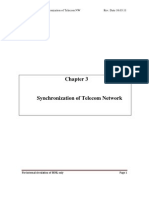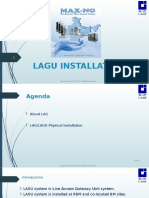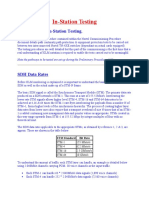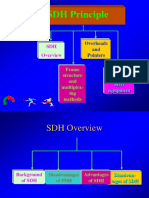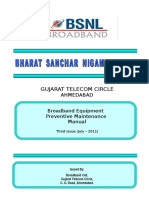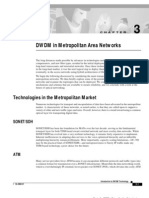Next Generation SDH
Next Generation SDH
Uploaded by
Aravind MauryaCopyright:
Available Formats
Next Generation SDH
Next Generation SDH
Uploaded by
Aravind MauryaOriginal Description:
Original Title
Copyright
Available Formats
Share this document
Did you find this document useful?
Is this content inappropriate?
Copyright:
Available Formats
Next Generation SDH
Next Generation SDH
Uploaded by
Aravind MauryaCopyright:
Available Formats
NEXT GENERATION SDH
1.0
INTRODUCTION
Innovation, the lifeline to survival in the telecommunication market, has spurred the
telecommunication industry to adopt NGSDH as the most economic and technologically feasible
solution for transmitting voice & data over carrier network. The new applications, mostly relying
on data packet technology, offer easy implementation and access to applications based on the
Internet, Mobile, Multimedia, DVB, SAN, Ethernet or VPN. The architectures are increasingly
demanding long haul transport that today can only be provided by SDH/SONET. These
technologies have a massive installed base, developed over recent decades. SDH/SONET has now
evolved, and is ready to adapt to the new traffic requirements.
Next Generation SDH enables operators to provide more data transport services while
increasing the efficiency of installed SDH/SONET base, by adding just the new edge nodes,
sometime known as Multi Service Provisioning Platforms (MSPP) / Multi Service Switching
Platforms (MSSP), can offer a Combination of data interfaces such as Ethernet, 8B/10B,
MPLS(Multi Protocol Label Switching) or RPR(Resilient Packet Ring), without removing those
for SDH/PDH. This means that it will not be necessary to install an overlap network or migrating
all the nodes or fiber optics. This reduces the cost per bit delivered, and will attract new customers
while keeping legacy services. In addition, in order to make data transport more efficient,
SDH/SONET has adopted a new set of protocols that are being installed on the MSPP/MSPP
nodes. These nodes can be interconnected with the old equipment that is still running.
WHAT IS NEXT GENERATION SDH?
2.0
Following major issues that exist in the legacy SDH:
Difficulty of mapping newer (Ethernet, ESCON, FICON, Fiber Channel etc) services to the
existing SDH transport network.
Inefficient use of the transport network in delivering data services.
Inability to increase or decrease available bandwidth to meet the needs of data services
without impacting traffic.
Three mature technologies
Generic Framing Procedure (GFP), ITU-T G.7041
Link Capacity Adjustment Scheme (LCAS), ITU-T G.7042
Virtual Concatenation (VCAT), ITU-T G.707
-together in Next generation SDH solved the above issues and adding three main features
to traditional SDH:
1. Integrated Data Transport i.e. Ethernet tributaries in addition to 2Mb, 140 Mb, STM1,4,16 ----GFP
2. Integrated non blocking, wide-band cross connect (2Mb granularity) making the efficient
use of the transport network in delivering data services ---VCAT
3. Dynamic Bandwidth allocation,
Intelligence for topology discovery, route computation and mesh based restoration-----LCAS
migrating all the nodes or fiber optics. This reduces the cost per bit delivered,
Fig. 1 Block Diagram of NGSDH
Next Generation SDH is Packet Friendly and have IP router like capabilities. It does not
matter if the client stream has constant or variable bit rates.
VCAT provides more granularity, LCAS provides more flexibility and GFP efficiently
transports asynchronous or variable bit rate data signals over a synchronous or constant bit
rate.
Hence,
Next Generation SDH = Classic SDH + [GFP+VCAT+LCAS]
3.0
COMPONENTS OF NEXT GEN SDH
3.1
GENERIC FRAMING PROCEDURE (GFP):
Generic Framing Procedure (GFP), an all-purpose protocol for encapsulating packet over
SONET (POS), ATM, and other Layer 2 traffic on to SONET/SDH networks. GFP is defined in
ITU-T G.7041 along with virtual concatenation and link capacity adjustment scheme (LCAS)
transforms legacy SDH networks to Next generation SDH networks.
GFP adds dynamism to legacy SDH. GFP is most economical way of adopting high speed
services, constant bit rate and variable bit rate, in SDH networks and can provide basis for evolving
RPR.
Fig. 2 Functional Model of GFP
There are actually two types of GFP mechanisms ;1. PDU-oriented known as Frame mapped GFP (GFP-F)
2. Block-code-oriented known as Transparent GFP (GFP-T)
3.1
GFP-F: -
GFP-F (Framed) is a layer 2 encapsulation in variable sized frames. Optimised for data
packet protocols such as DVD, PPP and Ethernet, MPLS etc Frame mode supports rate adaptation
and multiplexing at the packet/frame level for traffic engineering. This mode maps entire client
frame into one GFP frames of constant length but gaps are discarded. The frame is stored first in
buffer prior to encapsulation to determine its length. This introduces delay and latency.
3.2
GFP-T:
GFP-T is useful for delay sensitive services. GFP-T (Transparent) is a layer 1
encapsulation in constant sized frames. Optimized f or traffic based on 8B/10B codification
such as VoIP,DVB-ASI,1000BASE-T, SAN, Fibre Channel, and ESCON.
Fig. 3 GFP-F & GFP-T
Transparent mode accepts native block mode data signals and uses SDH frame merely as a
lightweight digital wrapper. GFP-T is very good for isocronic or delay sensitive protocols &SAN
(ESCON). GFP-T is used for FC, Gigabit Ethernet etc.
3.2
CONCATENATION (V-CAT & C-CAT) :
SDH concatenation consists of linking more than one VCs to each other to obtain a rate that
does not form part of standard rates. Concatenation is used to transport pay loads that do not fit
efficiently into standard set of VCs.
Two concatenation schemes are:
1. Contiguous concatenation
2. Virtual concatenation
Fig. 4: VCAT Efficiency
3.2.1
Contiguous concatenation:
The traditional method of concatenation is termed as contiguous. This means that adjacent
containers are combined and transported across the SDH network as one container. Contiguous
concatenation is a pointer based concatenation. It consists of linking N number of VCs to each
other in a logical manner within the higher order entity i.e. VC4 and above. The concatenated VCs
remain in phase at any point of network. The disadvantage is that it requires functionality at every
N/E adding cost and complexity. Lower order VCs (VC-12, VC3) concatenation is not possible in
contiguous concatenation as shown in Fig.
3.2.2
Virtual Concatenation:
Virtual concatenation maps individual containers in to a virtually concatenated link. Any
number of containers can be grouped together, which provides better bandwidth granularity than
using a contiguous method. It combines a number of lower/higher order VCs (VC-12, VC3 & VC4
payload) that form a larger concatenation Group, and each VC is treated as a member. 10 Mb
Ethernet would be made up of five VC-12s, creating these finely tuned SDH pipes of variable
capacities improve both, scalability and data handling/controlling ability as per SLA (service level
agreement).
The transport capacity with or without VC is shown in Fig. 4
VCs are routed individually and may follow different paths, within the network, only the
path originating and path terminating equipment need to recognize and process the virtually
concatenated signal structure as shown in Fig. 5
Transporting Concatenated Signals
Contiguous Concatenation
C-4
C-4
C-4
C-4
C-4
C-4
C-4
C-4
One Path
NE
C-4
C-4
C-4
C-4
NE
VC-4-4c
Core Network
Virtual Concatenation
Path 1
Differential Delay
VC-4
#1
VC-4
#2
VC-4
#1
VC-4
#1
VC-4
#1
VC-4
#2
VC-4
#2
Path 2
VC-4
#2
Fig. 5 Virtual & Contiguous Concatenation
VC-4-2v
Virtual concatenation Benefits:
1. Use the same core NEs, modify only edge NEs.
2. Low investment and fast ROI (return on investment).
3. Efficient & scalable i.e. fine granularity and multi-path capability.
4. SDH gives best QoS, well engineered and reliable.
3.3
Link Capacity Adjustment Scheme(LCAS):
Link Capacity Adjustment Scheme (LCAS) is an emerging SONET/SDH standard and is
defined in ITU-T G.7042 having capability to dynamically change the amount of bandwidth used
in a virtually concatenated channel i.e. bandwidth management flexibility. LCAS is bi-directional
signaling protocol exchanged over the overhead bytes, between Network Elements that continually
monitors the link. LCAS can dynamically change VCAT path sizes, as well as automatically
recover from path failures. LCAS is the key to provide bandwidth on demand.
LCAS enables the payload size of VCG (group of VCs) to be adjusted in real time by adding
or subtracting individual VCs, from VCG dynamically, without incurring hits to active traffic. In
LCAS, signalling messages are exchanged between the two VCs end points to determine the
number of concatenated payloads and synchronize the addition/removal of SDH channels using
LCAS control packets.
Benefits of LCAS :A . Call by call bandwidth (Bandwidth on demand)
Customer
rents a 6Mb Internet connection (VC-12-3v)
calls to get additional 2Mb
Operator
will provision additional VC-12 path
.and will hitless add it to existing connection via LCAS!
Fig. 6 Bandwidth call by call
B. Bandwidth on Schedule
A customer is offered a fixed bandwidth of 100 Mb (VLAN) Ethernet, allotting 46 VC-12 (
0ne VC12 = 2.176 Mb x 46 = 100.1 Mb). Every night for one hour additional 900 M ESCON
service is provisioned by LCAS. New revenue opportunity at low traffic hours.
Fig. 7 Bandwidth on scheduled Time
LCAS is not only used for dynamic bandwidth adjustment but also for survivability options
for next generation SDH. LCAS is a tool to provide operators with greater flexibility in
provisioning of VCAT groups, adjusting their bandwidth in service and provide flexible end-to-end
protection options. LCAS is defined for all high and low order payloads of SDH.
You might also like
- EOSDHDocument78 pagesEOSDHMukesh BhakarNo ratings yet
- CH1-E3-E4 CM-3G ConceptDocument19 pagesCH1-E3-E4 CM-3G ConceptAnne Campbell100% (1)
- MLLNDocument13 pagesMLLNksu2006100% (5)
- Next Generation SDH: Muhammad ZeeshanDocument51 pagesNext Generation SDH: Muhammad ZeeshanFarrukh AshfaqNo ratings yet
- Introduction To MadmDocument42 pagesIntroduction To MadmAravind Teja Mamidi100% (1)
- 4 - Jdsu NG SDHDocument8 pages4 - Jdsu NG SDHVictor PetrescuNo ratings yet
- NGSDHDocument39 pagesNGSDHrksingh00722No ratings yet
- Chapter01 MLLNDocument9 pagesChapter01 MLLNkisturscribdNo ratings yet
- Concept of ASONDocument52 pagesConcept of ASONMuhammad Bilal KhattakNo ratings yet
- MLLNDocument12 pagesMLLNPrashantNo ratings yet
- DWDM UtlDocument2 pagesDWDM Utlrohit00722100% (1)
- E4-E5 - Text - Chapter 4. CONVERGED PACKET BASED AGGREGATION NETWORK (CPAN)Document11 pagesE4-E5 - Text - Chapter 4. CONVERGED PACKET BASED AGGREGATION NETWORK (CPAN)nilesh_2014No ratings yet
- BSNL Training ReportDocument47 pagesBSNL Training ReportMeenakshi Gupta100% (1)
- Synchronization of Telecom NetworkDocument5 pagesSynchronization of Telecom Networkrohit00722No ratings yet
- Department of Electronics and Telecommunication: Pillai College of Engineering New Panvel - 410 206Document16 pagesDepartment of Electronics and Telecommunication: Pillai College of Engineering New Panvel - 410 206Venkatraman SubramanianNo ratings yet
- SDH Overhead and PointerDocument23 pagesSDH Overhead and PointerMahmoud TahaNo ratings yet
- Course On MLLN Overview: (E3-E4 E&WS)Document35 pagesCourse On MLLN Overview: (E3-E4 E&WS)Rohit Sharma100% (1)
- 2MB Mux PDFDocument114 pages2MB Mux PDFRohit Sharma100% (1)
- BSNLDocument27 pagesBSNLthreephasefaultNo ratings yet
- 10 LAGU InstallationDocument34 pages10 LAGU InstallationLavanya Mummadi50% (2)
- Leased Line (MLLN)Document18 pagesLeased Line (MLLN)deardestiny100% (2)
- 18b.lawful InterceptionDocument9 pages18b.lawful InterceptionJyotiRajputNo ratings yet
- SDH KLM MappingDocument10 pagesSDH KLM MappingAntariksha SinghNo ratings yet
- MODULE3 - NIB II Project 1 PDFDocument284 pagesMODULE3 - NIB II Project 1 PDFchvkrishna056No ratings yet
- SDH ProtectionDocument6 pagesSDH Protectionzylyz71% (7)
- ALC SDH Basics and Alcatel SDH System Training Presentation 46 SlideDocument46 pagesALC SDH Basics and Alcatel SDH System Training Presentation 46 SlideFrancisco Salvador MondlaneNo ratings yet
- Digital Microwave Communication Principles-ZTE PDFDocument113 pagesDigital Microwave Communication Principles-ZTE PDFRahul DeshwalNo ratings yet
- PCM PDH and SDHDocument58 pagesPCM PDH and SDHAkram Ba-odhan100% (1)
- Voip H.323: Session No.7Document60 pagesVoip H.323: Session No.7Ashay DoshiNo ratings yet
- Nib & MultiplayDocument35 pagesNib & MultiplayBirendra BhardwajNo ratings yet
- 1 MPLS Basic KnowledgeDocument19 pages1 MPLS Basic KnowledgeRandy DookheranNo ratings yet
- Index No. Name No: E4-E5 Customer Fixed Access IndexDocument148 pagesIndex No. Name No: E4-E5 Customer Fixed Access IndexvivekNo ratings yet
- On Pre of OtmDocument25 pagesOn Pre of OtmAamir Mohd100% (1)
- Cdot Maxng Migration Man V02 PDFDocument93 pagesCdot Maxng Migration Man V02 PDFDaya Ram Choudhary100% (1)
- Telecom Basics For BUGSDocument37 pagesTelecom Basics For BUGSGurpreet SinghNo ratings yet
- STM 1Document4 pagesSTM 1tajikkhass.mehdi9233No ratings yet
- SDH Principle PDFDocument51 pagesSDH Principle PDFSharka SanaullahNo ratings yet
- NetworksDocument206 pagesNetworksBSNL TRANSMISSION kathua100% (1)
- SDH & PDHDocument5 pagesSDH & PDHMohammad Faruque Hossain100% (5)
- Gujarat Telecom Circle: Ahmedabad Broadband Equipment Preventive Maintenance ManualDocument55 pagesGujarat Telecom Circle: Ahmedabad Broadband Equipment Preventive Maintenance ManualAaron Hongrei0% (1)
- Configuring Virtual LAN: VLAN Configuration in CyberoamDocument3 pagesConfiguring Virtual LAN: VLAN Configuration in CyberoamdasdsaNo ratings yet
- Introduction of MPLS ServicesDocument32 pagesIntroduction of MPLS ServicesNokia SolutionNo ratings yet
- Chapter07. NIBIIDocument7 pagesChapter07. NIBIINakarikanti PrabhakarNo ratings yet
- Introduction To Synchronization: Synchronous AsynchronousDocument91 pagesIntroduction To Synchronization: Synchronous AsynchronousAkhtar Mehmood100% (1)
- CUPS BNG SOP DOCUMENT MANUAL V1.0 - Print ReadyDocument56 pagesCUPS BNG SOP DOCUMENT MANUAL V1.0 - Print ReadySDETXCM CHIRAWA100% (1)
- SDHDocument91 pagesSDHbrightmsfstar100% (1)
- Switching System: University of DhakaDocument27 pagesSwitching System: University of DhakaAlamgir Kabir ShuvoNo ratings yet
- (K L M) Numbering Format in SDHDocument5 pages(K L M) Numbering Format in SDHmohamedNo ratings yet
- C-Dot Max-XlDocument39 pagesC-Dot Max-XlGourav Roy100% (3)
- 1 MPLS-TP Principles and Key TechnologiesDocument21 pages1 MPLS-TP Principles and Key TechnologiesJobs IndiaNo ratings yet
- MPLS-Enabled Applications: Emerging Developments and New TechnologiesFrom EverandMPLS-Enabled Applications: Emerging Developments and New TechnologiesRating: 4 out of 5 stars4/5 (4)
- LTE Self-Organising Networks (SON): Network Management Automation for Operational EfficiencyFrom EverandLTE Self-Organising Networks (SON): Network Management Automation for Operational EfficiencySeppo HämäläinenNo ratings yet
- Ethernet Over SDHDocument5 pagesEthernet Over SDHEng SugaalNo ratings yet
- LCAS BenefitsDocument5 pagesLCAS BenefitsjwalantudesaiNo ratings yet
- Optimization of Differential Delay in NGSDH Networks: R.KrishnamoorthyDocument6 pagesOptimization of Differential Delay in NGSDH Networks: R.KrishnamoorthyRakeshconclaveNo ratings yet
- Ch1 E3 E4 Ews NGSDH Concepts - TextDocument7 pagesCh1 E3 E4 Ews NGSDH Concepts - TextMd RajaulNo ratings yet
- Prod White Paper0900aecd802c8630Document10 pagesProd White Paper0900aecd802c8630Bui TheQuanNo ratings yet
- How To Reduce Cellular Backhaul Transport Costs While Improving 2G and 3G Network Operating EfficienciesDocument18 pagesHow To Reduce Cellular Backhaul Transport Costs While Improving 2G and 3G Network Operating EfficienciesPaulo DembiNo ratings yet
- Backhaul Satellite 2G - 3G - 4GDocument11 pagesBackhaul Satellite 2G - 3G - 4GPatrick Gelard100% (1)
- DWDM in Metropolitan Area NetworksDocument16 pagesDWDM in Metropolitan Area NetworksChuthaporn MarkyouNo ratings yet
- CBSE Class 2 English Sample Paper Set BDocument3 pagesCBSE Class 2 English Sample Paper Set BAravind MauryaNo ratings yet
- 5 Ffundamental Swcreeners Every Indian Investor Should KnowDocument26 pages5 Ffundamental Swcreeners Every Indian Investor Should KnowAravind MauryaNo ratings yet
- CBSE Class 2 English Sample Paper Set ADocument3 pagesCBSE Class 2 English Sample Paper Set AAravind Maurya100% (4)
- CBSE Class 2 Maths Practice Worksheets (125) - RevisionDocument12 pagesCBSE Class 2 Maths Practice Worksheets (125) - RevisionAravind MauryaNo ratings yet
- Rules & Regulations For The AgentsDocument8 pagesRules & Regulations For The AgentsAravind MauryaNo ratings yet
- Bank's Transaction Charges On IRCTC Website: Wallet and Cash CardDocument5 pagesBank's Transaction Charges On IRCTC Website: Wallet and Cash CardAravind MauryaNo ratings yet
- Escalation Matrix: Broadband Network Circle O/O GM, BBNW, BengaluruDocument14 pagesEscalation Matrix: Broadband Network Circle O/O GM, BBNW, BengaluruAravind Maurya100% (1)
- Ken Fisher "Super Stocks" Raimondas LenceviciusDocument13 pagesKen Fisher "Super Stocks" Raimondas LenceviciusAravind MauryaNo ratings yet
- Next Generation SDHDocument7 pagesNext Generation SDHAravind Maurya100% (1)
- B.B Maintenance Book MP 27.12.2011Document68 pagesB.B Maintenance Book MP 27.12.2011Aravind Maurya100% (3)
- Demoss AmwayDocument17 pagesDemoss AmwayAravind MauryaNo ratings yet













